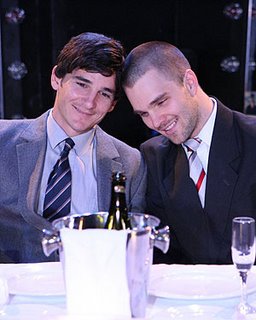Richard Watts talks with actors Matt Zeremes and Guy Edmonds, the stars of Holding the
Since its original publication in 1995, Tim Conigrave’s powerful and passionate memoir of love and loss in the first years of the AIDS crisis, Holding the Man, has engaged tens of thousands of readers worldwide.
It’s also moved almost all of them to tears.
The book, which Conigrave completed shortly before he died, tells the story of Tim’s enduring love for his partner, John Caleo; from their first, nervous meeting at Melbourne’s Xavier College, through to John’s untimely death from an AIDS-related illness at Fairfield Hospital. As a story it is by turns comical, remarkable and deeply – at times painfully - affecting.
In November 2006, a stage production of Holding the Man, adapted by Tommy Murphy and directed by David Berhold, was premiered by Sydney’s Griffin Theatre Company; the very same company with which Conigrave devised his own, critically acclaimed play about the impact of AIDS, Soft Targets, in 1986.
Holding the Man went on to become
Now, thanks to the Melbourne Theatre Company, local audiences will finally have a chance to see this critically acclaimed production, with Holding the Man having its opening night at Southbank’s CUB Malthouse Theatre tonight.
Guy Edmonds, who plays the character of Tim Conigrave, says he realised what an incredible play this was the moment he first read it.
“I wouldn’t have said we would be doing six seasons down the track … but I knew it was something special; something that resonated with people,”
“It was like nothing I’d read out of Australia for a long while. When we got into rehearsals great things were happening, and I thought ‘fuck, this is going to be alright’; but the clincher was opening night. Tim’s family came, and all the invited guests and everyone got it.”
Matt Zeremes, who plays Tim’s lover, John Caleo, believes that one of the reasons for the play’s success is the way it so clearly demonstrates Caleo’s love for his partner.
“I love the character of John. He’s a real joy to play. That completely committed love he has for Tim; I think that that’s a really great quality,” he says.
Anyone who has read Holding the Man will also recognise the love Conigrave had for Caleo; it infuses the memoir’s every page, but Conigrave himself was not so easy to love,
“Tim lived on impulse,” he says. “If he felt something, he acted on it; and he was always honest about how he felt, whether it was going to affect someone negatively or positively. I portray him honestly, like that. When he’s being nasty, he’s being nasty; when he’s loving John, he’s loving John. It was a bit tricky for me, because as Guy, I’m not that sort of person; so it took a while for me to understand that. But you understand him, and you empathise with him as well.”
Both actors say they were conscious, when first approaching the play, that they were playing real people, not fictional characters.
“I felt that there was more weight on my shoulders than in playing a fictional character, especially when I heard that members of Tim’s family would be coming to see the show,” Zeremes says, adding that the weight of expectation has also spurred him on to give the best performance he possibly can.
“I did and still do want to do a really good job with it; and that’s also because I believe that the story is so beautiful. I want to give it 100% every night, which an actor should always do, but with this story in particular there’s that determination to want to do a really good job.”
For
“Tommy had done a lot of research himself, and dug up a lot of things from Tim’s days at NIDA (the National Institute of Dramatic Arts), videos from productions for example, and some old video footage of him and John at a birthday party. So I listened and watched as much of his life as I can, but I didn’t want to get bogged down in mimicking Tim Conigrave.”
“At the end of the day, as a play he’s still a character; and though he was a real person and there’s a wealth of research there, both Matt and I didn’t want to get bogged down in getting the mannerisms. We wanted to take it beyond the real and turn it into something bigger.”
In the
“Some people ask, ‘You have to kiss a guy on stage; is that hard?’ which I think is a silly question,” he scoffs. “I don’t think it’s brave. That’s casting pretty negative aspersions on the gay world. That’s creating divisions, and there shouldn’t be divisions between any of us.”
The Melbourne Theatre Company presents the Victorian premiere of the Griffin Theatre Company’s Holding the Man at the Merlyn Theatre, The CUB Malthouse, March 14 – April 19. www.mtc.com.au




















 The paper reports:
The paper reports: